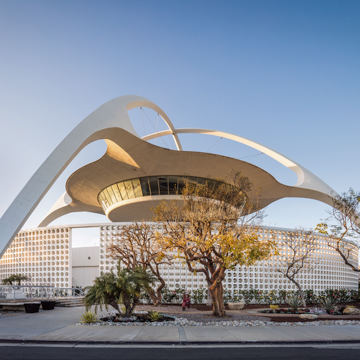No other building represents jet-age Los Angeles more appropriately than the LAX Theme Building, a disc-shaped, continuously glazed restaurant floating underneath 135-foot-tall, parabolic, stucco-wrapped steel arches above the center of Los Angeles International Airport (LAX).
The spidery, Googie-style building was meant, more than anything, to be an emblem for LAX, a $50 million, horseshoe-shaped jetway that heralded the city’s then-dominant place in the nation’s futurist psyche. The building was originally planned as the centerpiece of the airport itself; a grand, glassy, dome-shaped terminal. But eventually that practical vision morphed into a symbolic one: a restaurant and viewing deck taking on a style that authors Wim de Wit and Christopher Alexander call Southern California “fantasy architecture,” indicative of the whimsical visions of Walt Disney, and of architect William L. Pereira himself, who was for a time a noted movie set designer. While the architectural firm Pereira and Luckman oversaw the plan, its design was led by Gin Wong, who supervised a team that also included designers from Welton Becket and Associates.
The building’s restaurant sits on a concrete cylinder core, which is itself surrounded by a courtyard with plaques commemorating the opening of the airport. This core is then wrapped with a circular concrete block screen and surrounded by a warren of roads. The edifice’s structural elements, including the arches, horizontal legs, and tension and compression rings, are supported with about 900 tons of steel. These arches were originally meant to be clad in aluminum, but budget concerns forced the use of stucco instead. After a half-ton piece of stucco fell from the building in 2007, the structure underwent a renovation and seismic upgrade, reopening in 2010. The rooftop observation deck, which offered 360-degree views of departing and arriving jets, was closed after 9/11. In 2014, the restaurant permanently closed although the observation deck has since reopened during limited weekend hours.
References
De Wit, Wim, and Christopher James Alexander. Overdrive, L.A. Constructs the Future, 1940-1990. Los Angeles: Getty Research Institute, 2013.
Harrison, Scott. “How LAX’s Theme Building became an iconic symbol of Los Angeles.” Los Angeles Times, November 26, 2015.
“LAX’s Landmark Theme Building Opens.” Office of Historic Resources 4, no. 3 (July 2010): 2.
McBrien, Judith Paine, and John F. DeSalvo. Pocket Guide to Los Angeles Architecture. New York: W.W. Norton and Company, 2009.
McGill, Douglas C. “William L. Pereira, Architect; A Specialist in Planned Cities.” Obituary. New York Times, November 15, 1985.














